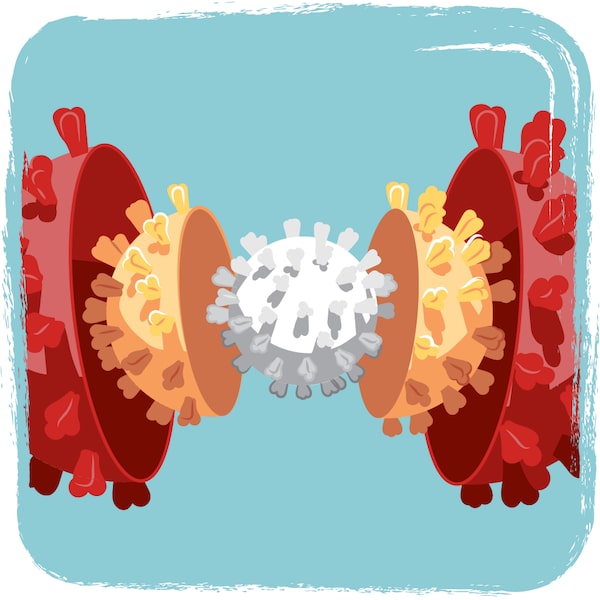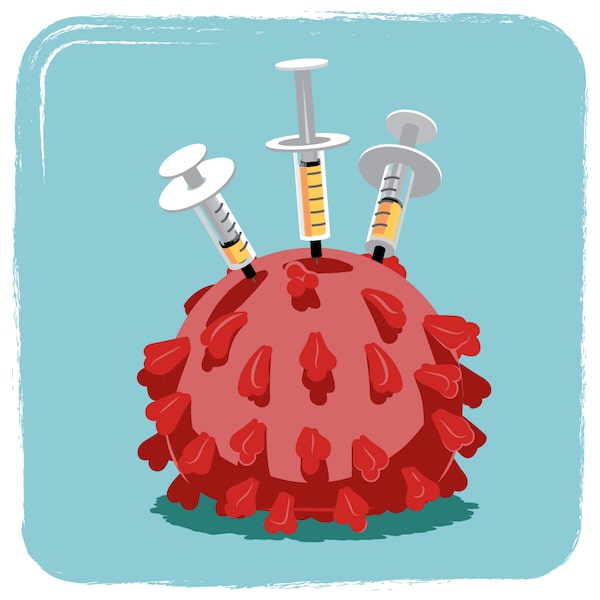COVID-19 is now in some ways less threatening to Canadians than ever. Widespread vaccination, prior infections and the introduction of new updated vaccines mean many Canadians have greater immunity against the disease than in previous years. New variants are better able to evade certain parts of the immune response, but they also appear to cause less severe infections.
In other ways, the country is arguably in a more precarious position. The mass departure of burned-out health care workers and staff shortages owing to illness and exhaustion mean there are fewer people to care for the sick and injured. This is happening just as COVID-19 infections, along with other seasonal respiratory illnesses, are expected to make a strong comeback, now that public-health precautions are vanishing. The health effects of repeat infections are not well understood. And fed up with the pandemic, some Canadians have become more reluctant to adopt further measures to curb the spread of disease.
The Globe and Mail spoke with several experts about the top five indicators of how the country will cope with COVID-19 in the coming months.

Hospital capacity
There were 5,070 COVID-19 patients hospitalized in Canada on Oct. 3, more than double the number hospitalized the same time a year ago, according to federal data. Meanwhile, 18,478 COVID-19 cases were reported across the country for the week of Sept. 25 to Oct. 1, up from a slight and short-lived dip in early September. These numbers, however, almost certainly underestimate the true counts.
A lack of PCR testing makes it difficult to get a clear picture of what the COVID-19 situation is like now, never mind what the rest of the fall and winter may hold, said Noel Gibney, a professor emeritus in the department of critical care medicine at the University of Alberta. But Canadian health professionals tend to keep a close eye on how influenza seasons play out during the southern hemisphere’s earlier winter to help predict what’s coming here. And this year, Australia simultaneously experienced a surge in COVID-19 and the worst influenza season in five years, according to news reports. If the same happens in Canada, “our hospitals are going to be under significant strain,” Dr. Gibney said.
Before the pandemic, hospitals in Canada typically saw an increase in patients during the fall and winter, starting as early as the end of September. This predictable surge was driven by various respiratory viruses, including influenza and respiratory syncytial virus, which were quelled by COVID-19 public-health measures that have since been lifted. In the past, the seasonal influx of patients seeking hospital care – combined with staff shortages as health care workers also came down with these viruses – often meant those requiring intensive care would have had to spend a significant amount of time in a hospital trauma room or another area of the emergency department while waiting for an available bed in the intensive care unit, Dr. Gibney explained.
Alternatively, calls were made for patients to be directed to other hospitals with ICU capacity.
Now, staff shortages owing to burnout and illness, which led to some emergency department closures this summer, will likely add further pressure on hospitals, he said.
Lengthy wait times and service disruptions continue to be a problem for some hospitals. Pediatric services at New Brunswick’s Chaleur Regional Hospital and Edmundston Regional Hospital have been temporarily suspended because of a shortage of nursing staff. At one point last week, the online dashboard for Vancouver area hospitals showed three hospital emergency departments were abnormally busy and overcrowded, and recommended patients go elsewhere. And late last month, Ottawa’s CHEO took to social media to ask parents to bring snacks, blankets and toys to make the wait as comfortable as possible for children seeking emergency care.
To prepare for the coming months, “the first thing we have to do is actually admit that it’s going to be problematic and to start looking at how are we going to manage and having contingency plans available,” Dr. Gibney said. That could mean further delays in surgical procedures, as ICU patients spill over to other areas of hospitals, or the reintroduction of team-based care, where experienced nurses supervise non-ICU nurses to look after critically ill patients, he said.

New variants
The Omicron variant, which can evade specific immune components, has produced multiple subvariants, including BA.5, now most common in Canada.
They also infect people in a different way, causing more nasal and upper airway infections than deep lung infections caused by earlier variants, said Sarah Otto, the computational biology and modelling pillar co-lead of the Coronavirus Variants Rapid Response Network, a national network of researchers.
In particular, Dr. Otto said she is keeping an eye on the Omicron subvariants BA.2.75.2 and BA.4.6, which could increase in prevalence in the coming months.
BA.2.75.2 has reportedly been on the rise in India, and BA.4.6 accounted for 8.7 per cent of COVID-19 test samples sequenced in Canada the week of Sept. 11.
New non-Omicron subvariants could still emerge, she said.
“I don’t think Omicron is the pinnacle of adaptation of SARS-CoV-2 in humans and we may see quite different variants arise,” Dr. Otto said.
For now, though, there are reasons to be optimistic. Since Omicron appears more efficient at infecting the upper respiratory tract, it is less likely to cause the type of deep lung infections that result in oxygen deprivation and require intubation, Dr. Otto said.
Bivalent vaccines now available in Canada, which target the original SARS-CoV-2 virus and Omicron, also provide updated protection, said Anna Blakney, an assistant professor of biomedical engineering at the University of British Columbia whose research focuses on mRNA vaccines.
It’s important, however, to spell out what the vaccines protect against.
The trials and the goal of COVID-19 vaccines were to prevent severe illness, hospitalization and death from the virus, Dr. Blakney said. It’s still unclear what antibody levels or cellular immunity levels people need to prevent transmission, she said.
While the vaccines do offer some level of protection against catching COVID-19, how much depends on multiple factors, she said. For example, people may be less likely to get infected if they’ve had a recent vaccine and a previous infection, and if they’re exposed to smaller amounts of the virus.
Because protection from the vaccines declines over time, and since a growing body of data suggests they can reduce the risk of long COVID, Dr. Blakney recommends that people keep up with their next eligible dose, especially now that other public-health measures have been lifted. “It’s more important than ever to actually get these vaccines because that’s what’s been shown to work. We’re still in a pandemic,” she said.

Deaths
Even though vaccines have protected many, COVID-19 remains a killer. By April, 2021, more than 22,000 COVID-19 deaths were recorded across Canada. Since then, the total has more than doubled to 45,394, according to the most recent federal data.
But that official count may, in fact, be far lower than the actual number. Around the world, countries commonly miss or under-report COVID-19 deaths – according to some estimates, by as much as two- to threefold, said Tara Moriarty, associate professor and infectious disease researcher at the University of Toronto and co-lead of COVID-19 Resources Canada, an organization comprised largely of volunteer scientists to help the public navigate the pandemic.
Before the initial Omicron wave, which started this past winter, Canada, not including Quebec, missed an estimated 30 to 50 per cent of COVID-19 deaths in its official count, Dr. Moriarty said. (A death may not be reported as a COVID-19 death if that person was not tested, she explained.)
Until the introduction of Omicron (after which data are not yet available), the greatest number of the excess deaths in the country – that is, how many more people died than expected in a normal year – was among retirement-age Canadians, ages 65 to 85, Dr. Moriarty said. Efforts to vaccinate and protect this group from infection should be a priority, she said.
Dr. Moriarty said she is worried that since the bulk of COVID-19 infections has so far been among people under age 40, more hospitalizations and deaths among older age groups will occur as infections among older Canadians catch up. Until now, a much smaller percentage of the country’s older population has caught COVID-19, largely owing to greater vaccine uptake and efforts they’ve taken to avoid infection. (An estimated 75 to 90 per cent of those under 40 have been infected, compared with between 40 to 60 per cent of Canadians over 40.)
Hypothetically, if the proportion of the population that’s been infected were to rise to 100 per cent, the number of deaths from Omicron would be expected to be double what it is now, Dr. Moriarity said. “We’re not at the tail end of this. We’re probably right at the middle,” she said.

Long COVID
Compared with earlier stages of the pandemic, it appears people now face a lower risk of developing long COVID, which includes a range of symptoms that linger long after initial infection, said Kieran Quinn, a clinician researcher at Toronto’s Sinai Health and an assistant professor at the University of Toronto. Most common symptoms include fatigue, shortness of breath and joint pain, which can be debilitating.
The condition seems less common than it used to be, as most Canadians have received COVID-19 vaccinations and current variants appear to cause less severe disease, said Dr. Quinn, who co-authored a paper on long COVID, also known as post-COVID condition, published last month by the now-dissolved Ontario COVID-19 Science Table.
Early in the pandemic, the World Health Organization estimated that 10 to 20 per cent of all people infected with COVID-19 would develop long COVID, lasting at least three months after infection, according to the Science Table brief. More recent estimates suggest the condition now likely affects between 2 and 10 per cent of vaccinated people, Dr. Quinn said.
That still represents a “not insignificant number of people,” he said. Moreover, it’s not yet clear what the risks are of developing long COVID and other complications after repeat infections.
That means efforts such as keeping up to date with vaccinations, wearing high-quality masks in indoor public places and improving indoor air quality continue to be as important as ever, he said.
“I want to hammer that home,” he said. “The best way to prevent long COVID is to prevent infection with COVID in the first place.”

Treatments
Canadians now have multiple treatments available for COVID-19, but there are some limitations to using them. Patients at an earlier stage of the disease may be given antiviral medications, such as Paxlovid or remdesivir, to stop the replication of the virus, said Beth Leung, a clinical pharmacist working in infectious diseases at Unity Health Toronto.
Both Paxlovid and remdesivir continue to work for all the variants of concern that have emerged so far. However, some people may not be able to safely use Paxlovid, which is taken as a combination of tablets, because of its potential interactions with other medications. Meanwhile, remdesivir is available only intravenously, which is not ideal for those who can’t easily access centres that administer it, Dr. Leung said.
A recent CBC News report found provinces had dispensed only a fraction of their supply of Paxlovid, prompting calls from some medical experts to provide it to more patients.
Anti-SARS-CoV2 monoclonal antibodies, such as sotrovimab, may also be given at the earlier stage of disease, within seven days of the onset of symptoms, she said. Another, Evusheld, is used as prophylaxis, that is, as a medication taken to prevent COVID-19 in people who are immunocompromised and for whom vaccines don’t work as well.
The trouble is that, in the same way new variants can escape immune protection from vaccines, they can also get around certain monoclonal antibodies, Dr. Leung explained. Monoclonal antibodies usually focus on a specific target area of the virus, but if those target areas are no longer present in new variants, the treatment loses effectiveness. For example, in lab testing, Evusheld works against BA.2, but not against BA.4/5, she said. This can make it challenging to treat patients, since clinicians don’t always know which strain of the virus they have, she said.
Patients at a later stage of illness and who have more severe disease may be treated with steroids, which can work against all variants, or anti-IL6 monoclonal antibodies, such as tocilizumab.
While there are further drugs in development that may be able to retain their ability to treat future variants, Dr. Leung said she didn’t know when they would be available in Canada, since the companies working on these drugs were not listed as having submitted an approval request from Health Canada.
COVID-19: More from The Globe and Mail
The Decibel
What is a bivalent vaccine? How can a sick person tell if they have COVID-19, the flu or something else? Dr. Lisa Barrett, an infectious disease specialist, joined The Decibel to answer that and other reader questions about the virus. Subscribe for more episodes.
More coverage
How much death, illness and disruption from COVID-19 infections are we willing to live with?
 Wency Leung
Wency Leung